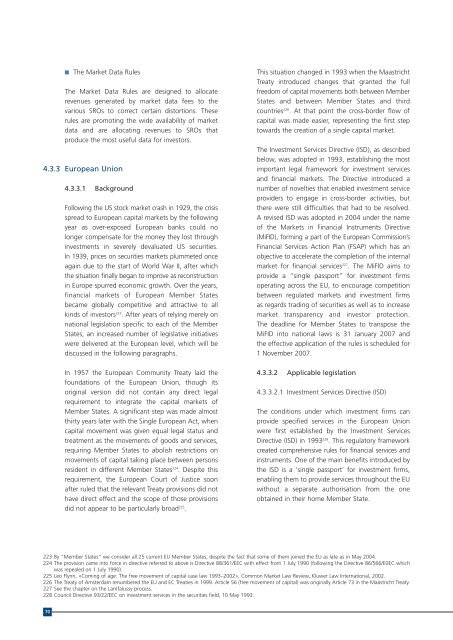A comparative analysis of the US and EU retail banking markets - Wsbi
A comparative analysis of the US and EU retail banking markets - Wsbi
A comparative analysis of the US and EU retail banking markets - Wsbi
You also want an ePaper? Increase the reach of your titles
YUMPU automatically turns print PDFs into web optimized ePapers that Google loves.
■ The Market Data Rules<br />
The Market Data Rules are designed to allocate<br />
revenues generated by market data fees to <strong>the</strong><br />
various SROs to correct certain distortions. These<br />
rules are promoting <strong>the</strong> wide availability <strong>of</strong> market<br />
data <strong>and</strong> are allocating revenues to SROs that<br />
produce <strong>the</strong> most useful data for investors.<br />
4.3.3 European Union<br />
4.3.3.1 Background<br />
Following <strong>the</strong> <strong>US</strong> stock market crash in 1929, <strong>the</strong> crisis<br />
spread to European capital <strong>markets</strong> by <strong>the</strong> following<br />
year as over-exposed European banks could no<br />
longer compensate for <strong>the</strong> money <strong>the</strong>y lost through<br />
investments in severely devaluated <strong>US</strong> securities.<br />
In 1939, prices on securities <strong>markets</strong> plummeted once<br />
again due to <strong>the</strong> start <strong>of</strong> World War II, after which<br />
<strong>the</strong> situation finally began to improve as reconstruction<br />
in Europe spurred economic growth. Over <strong>the</strong> years,<br />
financial <strong>markets</strong> <strong>of</strong> European Member States<br />
became globally competitive <strong>and</strong> attractive to all<br />
kinds <strong>of</strong> investors 223 . After years <strong>of</strong> relying merely on<br />
national legislation specific to each <strong>of</strong> <strong>the</strong> Member<br />
States, an increased number <strong>of</strong> legislative initiatives<br />
were delivered at <strong>the</strong> European level, which will be<br />
discussed in <strong>the</strong> following paragraphs.<br />
This situation changed in 1993 when <strong>the</strong> Maastricht<br />
Treaty introduced changes that granted <strong>the</strong> full<br />
freedom <strong>of</strong> capital movements both between Member<br />
States <strong>and</strong> between Member States <strong>and</strong> third<br />
countries 226 . At that point <strong>the</strong> cross-border flow <strong>of</strong><br />
capital was made easier, representing <strong>the</strong> first step<br />
towards <strong>the</strong> creation <strong>of</strong> a single capital market.<br />
The Investment Services Directive (ISD), as described<br />
below, was adopted in 1993, establishing <strong>the</strong> most<br />
important legal framework for investment services<br />
<strong>and</strong> financial <strong>markets</strong>. The Directive introduced a<br />
number <strong>of</strong> novelties that enabled investment service<br />
providers to engage in cross-border activities, but<br />
<strong>the</strong>re were still difficulties that had to be resolved.<br />
A revised ISD was adopted in 2004 under <strong>the</strong> name<br />
<strong>of</strong> <strong>the</strong> Markets in Financial Instruments Directive<br />
(MiFID), forming a part <strong>of</strong> <strong>the</strong> European Commission’s<br />
Financial Services Action Plan (FSAP) which has an<br />
objective to accelerate <strong>the</strong> completion <strong>of</strong> <strong>the</strong> internal<br />
market for financial services 227 . The MiFID aims to<br />
provide a “single passport” for investment firms<br />
operating across <strong>the</strong> <strong>EU</strong>, to encourage competition<br />
between regulated <strong>markets</strong> <strong>and</strong> investment firms<br />
as regards trading <strong>of</strong> securities as well as to increase<br />
market transparency <strong>and</strong> investor protection.<br />
The deadline for Member States to transpose <strong>the</strong><br />
MiFID into national laws is 31 January 2007 <strong>and</strong><br />
<strong>the</strong> effective application <strong>of</strong> <strong>the</strong> rules is scheduled for<br />
1 November 2007.<br />
In 1957 <strong>the</strong> European Community Treaty laid <strong>the</strong><br />
foundations <strong>of</strong> <strong>the</strong> European Union, though its<br />
original version did not contain any direct legal<br />
requirement to integrate <strong>the</strong> capital <strong>markets</strong> <strong>of</strong><br />
Member States. A significant step was made almost<br />
thirty years later with <strong>the</strong> Single European Act, when<br />
capital movement was given equal legal status <strong>and</strong><br />
treatment as <strong>the</strong> movements <strong>of</strong> goods <strong>and</strong> services,<br />
requiring Member States to abolish restrictions on<br />
movements <strong>of</strong> capital taking place between persons<br />
resident in different Member States 224 . Despite this<br />
requirement, <strong>the</strong> European Court <strong>of</strong> Justice soon<br />
after ruled that <strong>the</strong> relevant Treaty provisions did not<br />
have direct effect <strong>and</strong> <strong>the</strong> scope <strong>of</strong> those provisions<br />
did not appear to be particularly broad 225 .<br />
4.3.3.2 Applicable legislation<br />
4.3.3.2.1 Investment Services Directive (ISD)<br />
The conditions under which investment firms can<br />
provide specified services in <strong>the</strong> European Union<br />
were first established by <strong>the</strong> Investment Services<br />
Directive (ISD) in 1993 228 . This regulatory framework<br />
created comprehensive rules for financial services <strong>and</strong><br />
instruments. One <strong>of</strong> <strong>the</strong> main benefits introduced by<br />
<strong>the</strong> ISD is a ‘single passport’ for investment firms,<br />
enabling <strong>the</strong>m to provide services throughout <strong>the</strong> <strong>EU</strong><br />
without a separate authorisation from <strong>the</strong> one<br />
obtained in <strong>the</strong>ir home Member State.<br />
223 By “Member States” we consider all 25 current <strong>EU</strong> Member States, despite <strong>the</strong> fact that some <strong>of</strong> <strong>the</strong>m joined <strong>the</strong> <strong>EU</strong> as late as in May 2004.<br />
224 The provision came into force in directive referred to above is Directive 88/361/EEC with effect from 1 July 1990 (following <strong>the</strong> Directive 86/566/E0EC which<br />
was repealed on 1 July 1990).<br />
225 Leo Flynn, «Coming <strong>of</strong> age: The free movement <strong>of</strong> capital case law 1993–2002», Common Market Law Review, Kluwer Law International, 2002.<br />
226 The Treaty <strong>of</strong> Amsterdam renumbered <strong>the</strong> <strong>EU</strong> <strong>and</strong> EC Treaties in 1999. Article 56 (free movement <strong>of</strong> capital) was originally Article 73 in <strong>the</strong> Maastricht Treaty.<br />
227 See <strong>the</strong> chapter on <strong>the</strong> Lamfalussy process.<br />
228 Council Directive 93/22/EEC on investment services in <strong>the</strong> securities field, 10 May 1993.<br />
70
















